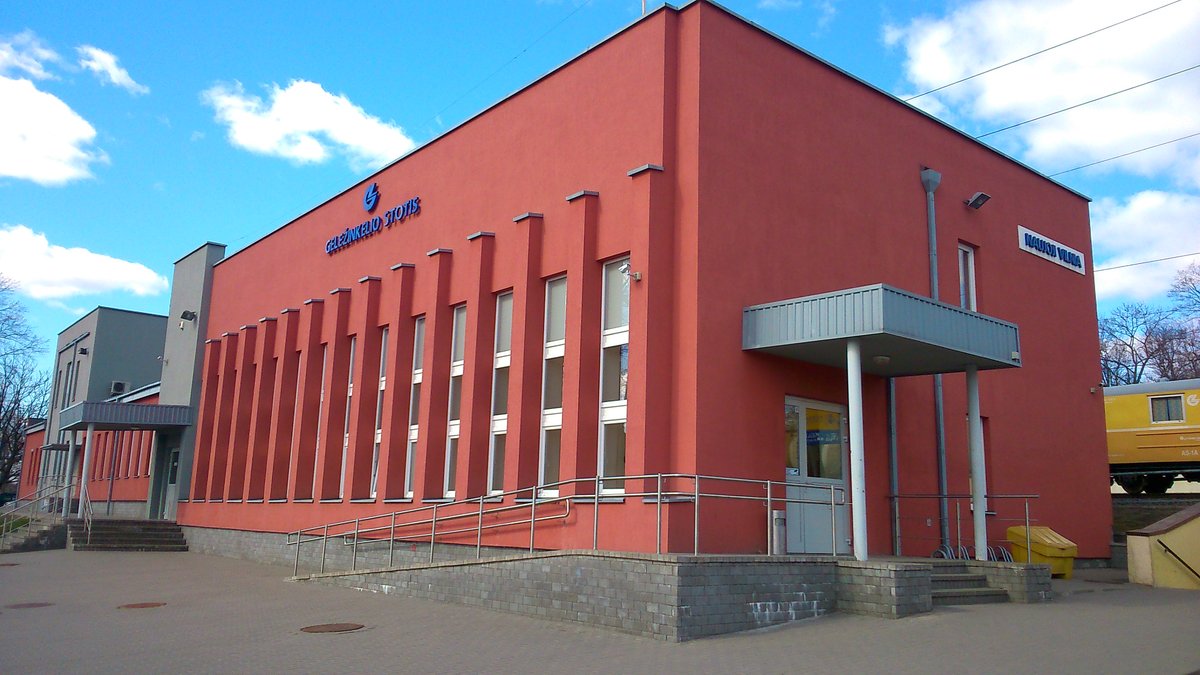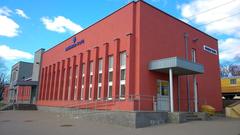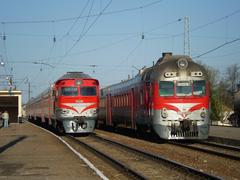
Naujoji Vilnia Train Station: Visiting Hours, Tickets, and Travel Guide
Date: 15/06/2025
Introduction
Naujoji Vilnia Train Station is a landmark of industrial heritage and cultural memory in Vilnius, Lithuania. Situated in the eastern district, this historic rail hub has played a pivotal role in shaping the area’s development, from its origins in the 19th century Russian Empire to its significance during the Soviet era and its present-day role as a vibrant gateway to Vilnius’s eastern neighborhoods. This guide provides detailed information on visiting hours, ticketing, accessibility, local history, and nearby attractions—ideal for travelers, history enthusiasts, and commuters alike (True Lithuania, Made in Vilnius, Neakivaizdinis Vilnius).
Table of Contents
- History and Significance
- Architectural Features and Memorials
- Visiting Hours and Ticketing
- Facilities and Accessibility
- Guided Tours and Cultural Life
- Nearby Attractions
- Practical Visitor Tips
- Frequently Asked Questions (FAQ)
- Conclusion
- References
History and Significance
Origins and Urban Development
Established in the late 19th century, Naujoji Vilnia Train Station was integral to the Saint Petersburg–Warsaw railway line. Its arrival spurred the transformation of Naujoji Vilnia from a rural suburb into a thriving industrial and residential district. The area, once an independent town before World War II, experienced rapid growth as factories, housing for railway workers, and supporting infrastructure emerged around the station (True Lithuania).
Role in Soviet Deportations
A somber chapter in the station’s history unfolded between 1941 and 1952, when it became a major site for Soviet deportations. Approximately 300,000 Lithuanians were forcibly sent to Siberia and other remote regions. Memorials at the station honor the memory of those affected, including symbolic monuments, preserved railway cars, and commemorative plaques (True Lithuania, Neakivaizdinis Vilnius).
Community and Cultural Identity
Naujoji Vilnia is home to a diverse population—Lithuanian, Polish, Russian, Belarusian, and Jewish communities have all contributed to the area’s unique character. Today, the station acts as both a literal and symbolic meeting point, hosting community events and serving as a springboard for exploring the multicultural fabric of the district (explorecity.life).
Architectural Features and Memorials
The station complex combines 19th-century brick buildings with a utilitarian Soviet-era structure from the 1970s. The surrounding district features a blend of historic homes, industrial remnants, and notable religious sites such as the Saint Casimir Roman Catholic Church (1911) and a wooden Orthodox church (1908). Memorials, including the poignant ‘Prarastoji karta’ (“The Lost Generation”) monument, keep the memory of deportation victims alive (Neakivaizdinis Vilnius, ArchDaily).
Visiting Hours and Ticketing
- Station Operating Hours: Daily, from 5:00 AM to 11:00 PM.
- Ticket Office Hours: Typically 6:00 AM to 10:00 PM; automated ticket machines are available 24/7.
- Memorial and Grounds Access: 8:00 AM to 6:00 PM; free of charge for memorial visits (Made in Vilnius).
- Train Tickets: Prices range from €1.50 to €10 depending on destination and train type. Tickets can be purchased at the station, via bilietas.ltglink.lt, or through apps like Omio and The Trainline. Discounts are available for children, students, and seniors. Tickets must be validated before boarding (Trenopedia).
Facilities and Accessibility
- Waiting Areas: Sheltered seating and basic restroom facilities.
- Amenities: Vending machines for snacks and drinks; nearby shops and kiosks.
- Accessibility: Step-free access and ramps; tactile guidance paths; elevators. For specialized assistance, contact Lithuanian Railways in advance.
- Security: Regular staff, security cameras, and lighting. Exercise standard urban precautions after dark.
Guided Tours and Cultural Life
- Guided Tours: Historical tours focusing on the station’s heritage and the deportations are available on weekends or by appointment through Vilnius tourism centers and local operators.
- Community Events: Local markets, cultural festivals, and public art installations reflect the district’s multicultural spirit (explorecity.life).
Nearby Attractions
- Religious Landmarks: Saint Casimir Roman Catholic Church, Orthodox Church of the Mother of God.
- Pavilniai Regional Park: Walking trails, scenic viewpoints, and the Belmontas area for recreation (Go Vilnius).
- Markets: Local food and craft markets offer a taste of Lithuanian and Eastern European culture.
- Industrial Heritage Sites: Explore the district’s historic factories and the ongoing transformation through urban renewal projects.
Practical Visitor Tips
- Plan Ahead: Check train schedules and station hours online or via the LTG Link app.
- Ticket Purchase: Use machines or online platforms for convenience.
- Accessibility: If needed, arrange for assistance in advance.
- Travel Light: Keep valuables secured; carry some cash for small purchases.
- Explore Locally: Allocate time to visit parks, memorials, and markets.
- Photography: Capture the blend of historic and modern architecture, especially in the golden hour.
- Language: English is commonly spoken among younger staff and residents.
Frequently Asked Questions (FAQ)
Q: What are the Naujoji Vilnia Train Station opening hours?
A: The station is open daily from 5:00 AM to 11:00 PM. Ticket offices operate from 6:00 AM to 10:00 PM, while ticket machines are available 24/7.
Q: How can I buy tickets?
A: At the station’s counters, ticket machines, or online via the Lithuanian Railways website and apps.
Q: Is the station accessible for disabled visitors?
A: Yes, with step-free access, ramps, and elevators; contact Lithuanian Railways for additional assistance.
Q: What attractions are nearby?
A: Saint Casimir Church, Orthodox churches, Pavilniai Regional Park, and local markets.
Q: Are guided tours available?
A: Yes, tours are offered by local operators and cultural organizations, especially on weekends or by appointment.
Q: Is it safe to visit?
A: Vilnius is generally safe; standard precautions are advised, especially in crowded or isolated areas (Basic Planet).
Conclusion
Naujoji Vilnia Train Station is more than a transport hub; it is a living monument to the history, resilience, and diversity of Vilnius. With accessible facilities, efficient connections, poignant memorials, and a multicultural neighborhood to explore, the station offers a rich experience for every visitor. As Vilnius continues to modernize and focus on sustainable mobility, Naujoji Vilnia’s role as a gateway to the east and a center of community life will only grow.
Stay updated on train schedules, ticketing, and events via the Lithuanian Railways website or by downloading the Audiala app. For cultural events and local news, follow Vilnius tourism channels and social media platforms.
References and Further Reading
- Suburbs of Vilnius – Naujoji Vilnia (True Lithuania)
- Naujoji Vilnia Features and News (Made in Vilnius)
- Naujoji Vilnia District Study (Neakivaizdinis Vilnius)
- Explore City Life in Vilnius
- LTG Link – Ticket Machines and Online Sales
- Trenopedia – Train Travel in Lithuania
- Go Vilnius – Top Destinations 2025
- Basic Planet – Lithuania Safety Travel Tips
- ArchDaily – Industrial Villa Project
- Radzima – Naujoji Vilnia
- Unusual Traveler – Things to Do in Vilnius




























































































